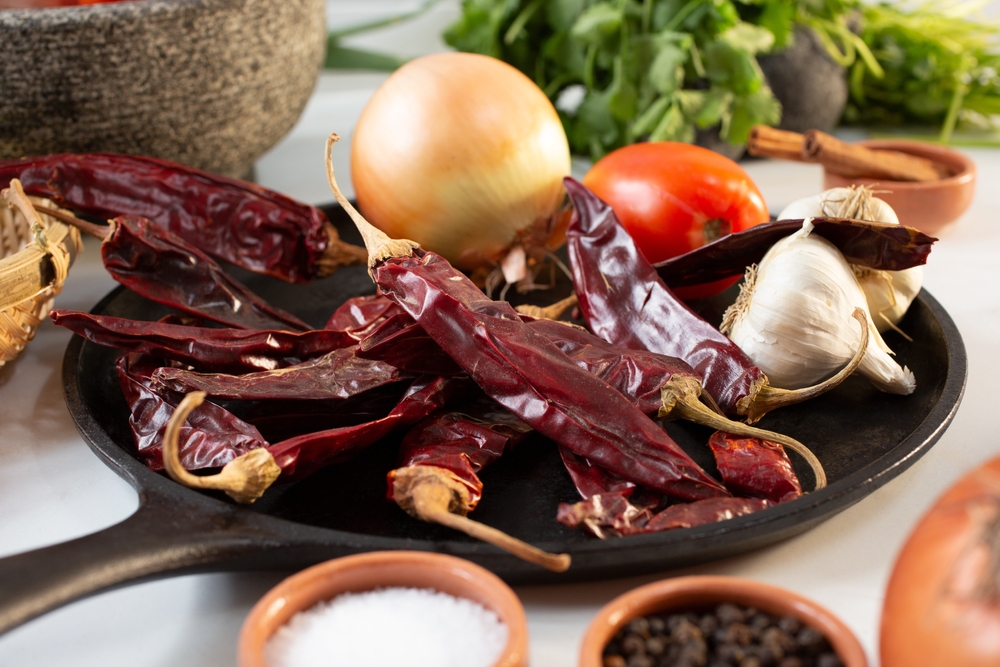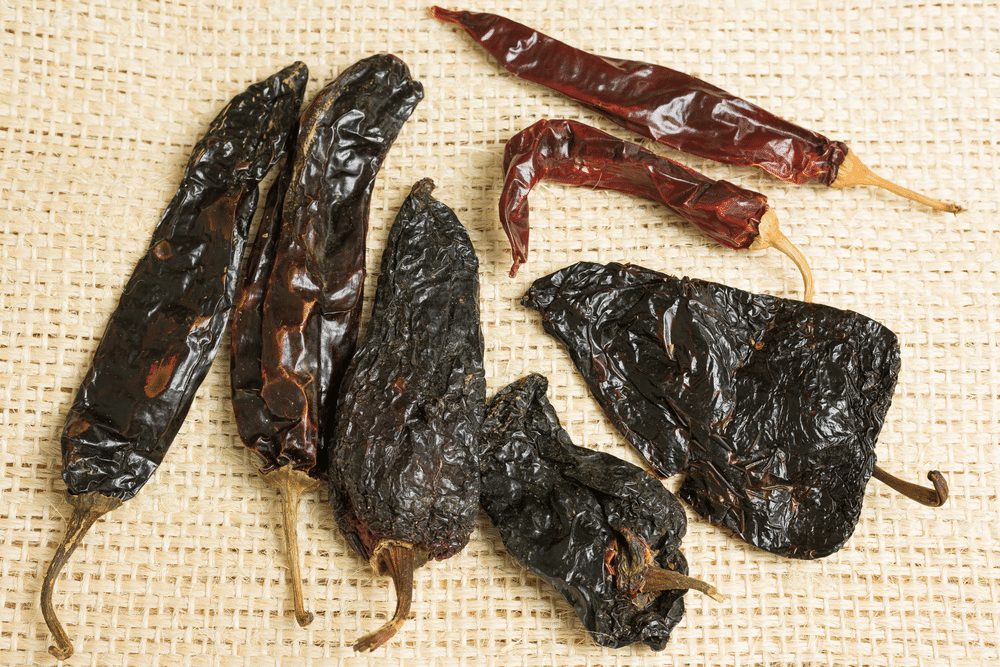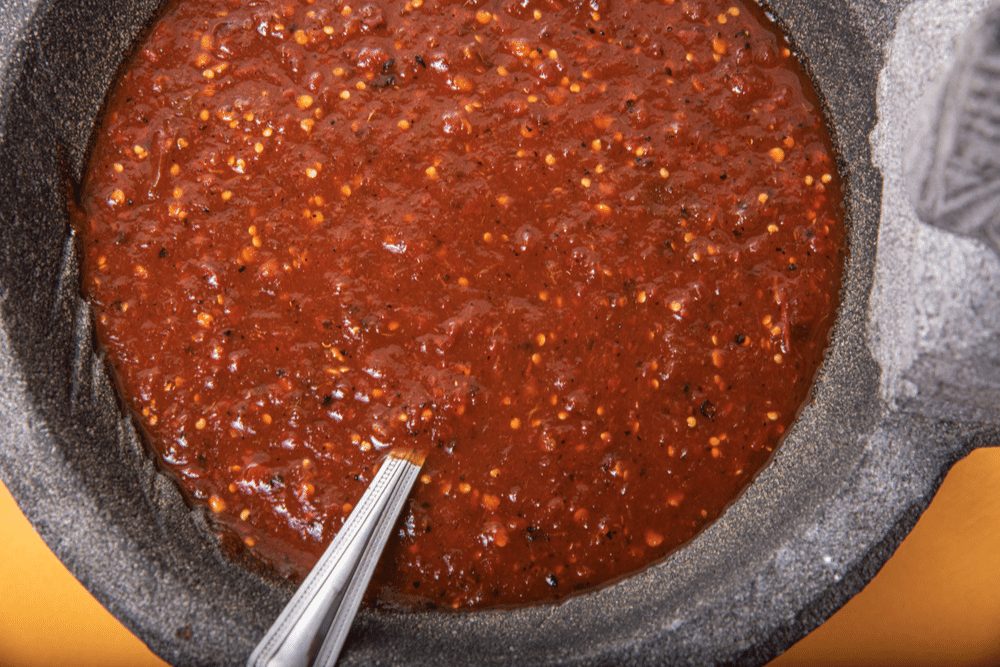Also called salsa de guajillo in Mexico, guajillo sauce is a mild red pepper sauce common in Mexican cuisine for its sweet, earthy, tangy, and smoky flavor. Its main ingredient is guajillo peppers, and it traditionally features no tomatoes.
What Is Guajillo Sauce?
Guajillo sauce is a popular, highly versatile mild Mexican condiment made with dried red peppers, olive oil, water, garlic, onions, and kosher salt as the core ingredients.
Guajillo sauce recipes vary from chef to chef or country to country. Apart from the core ingredients mentioned above, spices and herbs like cumin, cilantro (coriander), Mexican oregano, chili powders, cloves, and dried basil may be added individually or in varying combinations.
If you like your sauces with a more tangy flavor, you could make your guajillo sauce with a touch of lemon juice, apple cider vinegar, or lime juice. The acidity in these sour ingredients also makes the sauce last longer.
Guajillo sauce may also feature honey or brown sugar if you want to make it sweeter.
Some cooks add tomato puree to make the guajillo sauce thicker and more savory.

What Does Guajillo Sauce Taste Like?
Guajillo sauce has a slightly earthy, naturally sweet, smoky, and fruity flavor.
Since the sauce is made from rehydrated whole dried red guajillo peppers, the taste profile might include a slight bitterness if you use the rehydrating water rather than fresh water to blend the sauce.
Is Guajillo Sauce Spicy?
Guajillo sauce is a mildly spicy chili sauce derived from guajillo red peppers that score only 2,500-5,000 Scoville Heat Units.
The spiciness of guajillo sauce can be increased by adding hotter chiles like de a rbol chiles (15,000-30,000 SHUs) and red serrano peppers (10,000-23,000 SHUs).
What Pepper Does Guajillo Sauce Come From?
The main ingredient in guajillo sauce is guajillo peppers. Guajillo chiles, or chile cascabel anchos, as they are called in the state of Guanajuato, are the dried form of mirasol chiles. They have dark-red leathery skin that’s soft and pliable.
To make the sauce, the dried guajillo chiles are destemmed, deveined, deseeded, toasted (or used untoasted), and steeped in hot water for 20-30 minutes or in cold water for an hour.
Also called chile guajillo in Mexico, guajillo peppers are mild peppers scoring 2,500-5,000 SHUs on the Scoville Scale, which explains why guajillo chile sauce is mildly spicy.
The complex flavor profile of guajillo sauce is primarily from the dried papers, which are fruity, slightly smoky, a little tangy, and somewhat earthy peppers with undertones of green tea and berries.
Dried guajillo chiles are rich in vitamin A, fiber, magnesium, and iron. They also have B vitamins and vitamin C.
How Is Guajillo Sauce Used?
The versatility of guajillo hot sauce makes it a must-have condiment in your kitchen!
Here’s how you can use the sauce:
- As a dipping sauce for bread, corn chips, tortilla chips, tacos, and raw vegetables
- As a marinade for meats, such as pork and chicken for tacos, burritos, and tamales
- In mole sauce with other dried chili peppers like pasilla and chile de arbol
- As a topping or garnish on quesadillas, breakfast eggs, seafood, and sopes (a popular Mexican dish based on corn tortillas)
- Seasoning tamales dough
- As a substitute for other sauces, such as enchilada sauce
What’s The Difference Between Guajillo And Chipotle?
Both guajillo chiles and chipotle peppers are dried versions of different red peppers. Guajillo chiles are the dried version of mirasol peppers, while chipotle chiles are the smoked, dried version of ripe jalapenos.
The other difference between the two peppers is their heat profile. Chipotle peppers score 2,500-8,000 SHUs. They are slightly hotter than guajillo peppers, which score 2,500-5,000 SHUs on the Scoville pepper heat scale.
Substitutes For Guajillo Chiles
If you can’t find guajillo chiles, or you want to experiment with other dried chiles, there are several substitutes you can try.
Replacing guajillo peppers entirely with these substitute peppers will technically change the sauce from guajillo-based. The flavor and spiciness will also vary.

Ancho Chiles
Ancho chiles have a mild heat level (1,000-2,000 SHUs) and a sweet, earthy, nearly chocolatey flavor. This will be similar to guajillo sauce’s sweet, slightly earthy flavor.
Pasilla Chiles
An even closer substitute in flavor to chile guajillo would be the milder pasilla pepper or chile negro. At 250-2,500 SHUs, the hottest chile pasilla is only as hot as the least spicy guajillo chile. Pasilla peppers are sweet, earthy, smoky, tangy, woodsy, and fruity. They have hints of berries and cocoa.
Anaheim Peppers
Anaheim peppers are generally milder than guajillo peppers. They have a heat score of 500-2,500 SHUs on the Scoville Scale. The peppers also have a similar taste profile as chile guajillos—they are sweet, earthy, tangy, smoky, and slightly fruity, with undertones of raisin, dried cherry, and plum. They have hints of grassiness and acidity.
These substitutes are usually available in the Mexican/Latin aisle of grocery stores and supermarkets or online store stores like Amazon.
Guajillo Sauce Versus Other Red Sauces & Salsas
Guajillo sauce is often used interchangeably with other sauces and salsa, like ranchero sauce, salsa roja, and salsa brava. Before you decide on the next suitable sauce or salsa recipe, you should know the fundamental differences between the four.
Ranchero Sauce Vs. Guajillo Sauce
While ranchero sauce is a cooked condiment, guajillo sauce is usually a blended condiment.
Ranchero sauce involves cooking onions, peppers, olive oil, garlic cloves, tomatoes, chicken broth, cilantro, spices, and herbs over medium-high heat. Lime juice is then added to the cooled cooked sauce before blending it in a food processor or blender for consistency.
On the other hand, the only cooking you’ll do when making guajillo chile sauce is if you opt to toast the dried peppers before steeping them in cold or hot water. Toasting the peppers brings out their flavor better.
The two other critical differences between guajillo salsa and ranchero sauce are that the latter is tomato-based and jalapeno-focused. In contrast, guajillo chili sauce focuses on peppers and rarely features tomatoes.
Salsa Roja Vs. Guajillo Sauce
Salsa roja is a highly subjective and customizable sauce depending on the person preparing it. It’s the thin red salsa most commonly associated with a basket of tortilla chips in any Mexican restaurant.
It may contain any number of dried or fresh peppers, and is usually tomato-based. Like ranchero sauce, it’s also typically cooked, with some recipes simmering for a long time to achieve a rich, deep flavor.
Salsa Brava Vs. Guajillo Sauce
Salsa brava, or bravas sauce, is a cooked condiment. The Spanish sauce involves cooking a vegetable base comprising onions, peppers, garlic, smoked paprika, hot paprika, tomatoes, sugar, vinegar, and salt in vegetable oil over medium heat. The cooled sauce is then blended in a blender or food processor.
The other notable difference in salsa brava is the ingredients used. While guajillo sauce traditionally features no tomatoes or tomato puree, smoked paprika and hot paprika are incorporated in salsa brava.
Also, guajillo sauce focuses on guajillo chilis, while bravas sauce is open to any red peppers, such as cayenne or pimentón dulce.

